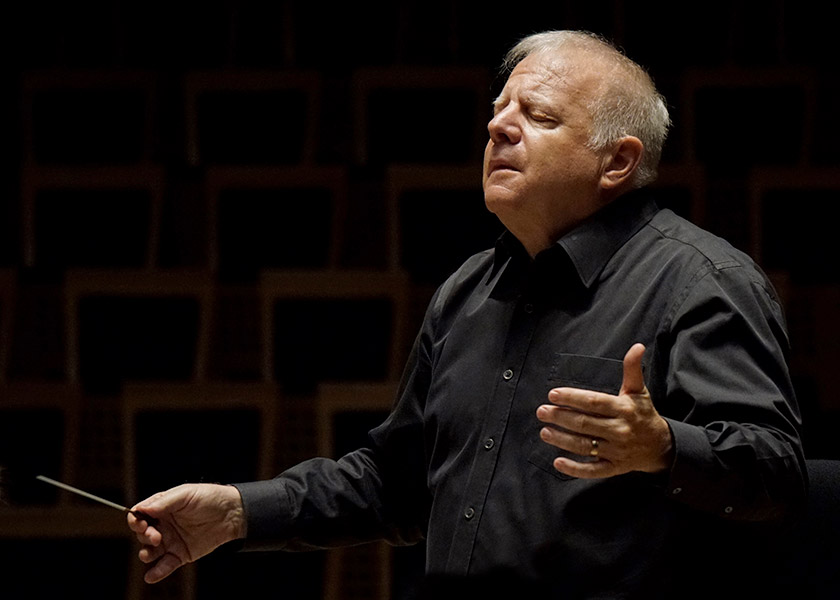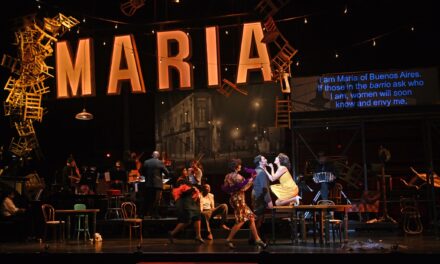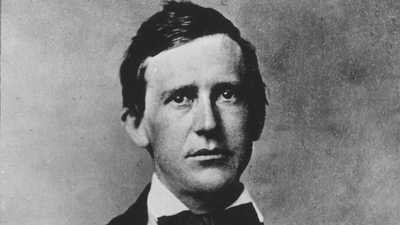Leonard Slatkin. Photo: Cindy McTee.
Slatkin Conducts Elgar
Louisville Orchestra
Guest Conductor, Leonard Slatkin
Review by Annette Skaggs
Entire contents are copyright © 2019 Annette Skaggs. All rights reserved.
Not too many years ago conductors, composers, and musicians were looked on like celebrities, elevated and treated like superstars. As well they should be. So it should come as no surprise that Maestro Leonard Slatkin is one of classical music’s superstars. Having conducted essentially every major orchestra and opera company throughout the world, not to mention his prowess as a composer, author, and educator, his second appearance in front of our Louisville Orchestra was an honor and a treat. Mr. Slatkin was here once before while we were under the baton of Maestro Moritz Bomhard.
While the concert featured Elgar’s Variations on an Original Theme [“Enigma”], Op 36, the audience was treated to three other pieces that I felt were just as, if not more compelling than Enigma.
The evening began with Cindy McTee’s Double Play, a piece containing two movements, “The Unquestioned Answer” and “Tempus Fugit”. According to the composer, the movements can be performed separately, but based on the musical themes of each, I found that they complemented one another quite well. The first sounds that we hear in “The Unquestioned Answer” is the rainmaker, bringing thoughts of a gentle rain cascading outside, dampening the Earth, or perhaps the Sahara. But that imagery is broken quickly as tempestuous strings and discordant brass take over. Just when you think the music will find a balance a full onslaught of percussion takes over and gives the listener a different aural sensation. It is a wonderful ride. As this movement has fitful moments, the second movement feels, as the title suggests, that it is fleeing time. There is a tick-tock that begins the movement and throughout there are moments of tranquility and retrospect. Suddenly a pop of celebration breaks forth, reminiscent of the West Side Story rhumba. But, celebrations fizzle out and we come back to a calm and introspective ending. What a pleasure to have Ms. McTee in the audience and to have her husband conduct her piece.
Maestro Slatkin’s piece, Kinah, is a musical elegy to his late parents. The story, as told by Mr. Slatkin, that his talented parents were to perform Brahms’ Duet for Violin and Cello for a very excited audience for the first time in California when he was 19. Unfortunately, his beloved father passed the night before the concert, so the world did not get to enjoy the magic that his parents had created within that piece. Using a four-note motif that is found within the Brahms, Mr. Slatkin composed a breathtaking musical testament to life, love, and loss. A violinist and cellist are off stage, symbolizing his parents and offering just the slightest nod to the Brahms duet. Also off stage is a trumpet and flugelhorn that intone the elegy. Found within the whole of the piece are broken phrases that encircle the motif, but often don’t complete it and is scattered among all of the instruments. As the build-up increases, there is a slight rest where the use of xylophone gives us a feeling of calm, an ethereal effect. Overall, the piece is stunning and gorgeous.
While not performed too often as a ballet any longer, Walter Piston’s “Suite from The Incredible Flutist” was a lot of fun. This 12-piece suite narrates the story of the ballet. In listening to the piece I couldn’t help but think of the flutist as a Pied Piper of sorts. For example, the flutist even charms the snakes at the Circus that has come into town. The brilliance of this piece is that you can hear the events of the story within the music. Through the use of soft winds and brass, I heard the sleepiness of the town as it starts to rise when the sun comes up. You can almost see the Circus parade as it passes through the town, complete with orchestra members waving hats in the air and whooping and hollering its arrival. When the flutist arrives, beautifully performed by Kathy Karr, one can envision the musicality and exuberance of the character. As the Minuet and Spanish Waltz begin, despite having a Carmen-like feel to it, one would have the inkling to rise and dance along. The party winds down with Eight O’clock Strikes, featuring a gorgeous melody in the viola section that is reminiscent of a lullaby. Not to be outdone, the all-nighters are still out dancing during Siciliana, to which Maestro Slatkin injected playfulness with the cellos and the Polka Finale. Over the years, at the end of the Circus March, the sound of a dog’s bark makes its way through (often sounded by a member of the orchestra), but Maestro Slatkin uses his own beloved pets when he has recorded it.
When Elgar was asked about the Variations theme he has always been pretty tight lipped about it. Beginning with the theme only labeled as Andante, 14, variations of said theme follow suit. And how are they named? Here’s part of the mystery. Most are single names such as #10’s “Dorabella” while the others are initials like #5’s “R.P.A.”, or even more enigmatic – #13’s “Romanza, ****”. Try to crack that code, if you can. As you might have surmised all kinds of guesses and theories have evolved through the years as to these meanings and at the time of its composition explanations were guarded. This actually helped propel Elgar’s career as a composer. Before the Enigma Variations, he was a musical tinkerer.
Suffice it to say that most of the Variations’ meanings have surfaced, but still remain a question as to why. Would you believe that the theme is not found throughout the course of the Variations? There are actually different sections throughout the Andante, but they do not resurface. And the initials? Most are nods to people who were important in Elgar’s life, who are now memorialized in music still played 100 years later.
One of the beauties of the variations is that there are often no breaks between the movements, therefore making it difficult to figure out which Variation you may be listening to, such as #5 into #6 and a deceptive lead with a single note that holds #8 to #9. Speaking of #9, “Nimrod”, it is perhaps the most commonly played movement of the Variations. It has been used in film scores, television commercials/shows and is often heard during solemn occasions, such as funerals and memorial services.
While there is not a singular musical theme found within the whole of the piece, there is a common thread. That thread would be Elgar’s insistence on having a solid lower register string section. Some of the lushest and memorable melodies can be found within the violas, cellos and bass lines.
The last movement, Finale, “E.D.U.”, which we now know is Elgar’s wife’s nickname for him, is a summation of all that Elgar had worked for till that point and is finished off with great robust energy.
What a pleasure to have Mr. Slatkin, a mentor of Maestro Abrams and one of the top composers/conductors of the 20th/21st Centuries come to grace our stages once again and introduce Louisville audiences to more fantastic music. It is nice to shake things up now and again.
Bravi Tutti!!!
Slatkin Conducts Edgar
January 12, 2019
Louisville Orchestra
Kentucky Center for the Performing Arts
Whitney Hall
501 W. Main St
Louisville, KY 40202
louisvilleorchestra.org
Annette Skaggs is heavily involved as an Arts Advocate here in Louisville. She is a freelance professional opera singer who has performed throughout Europe and in St. Louis, Cincinnati, Boulder, Little Rock, Peoria, Chicago, New York and of course Louisville. Aside from her singing career, she has been a production assistant for Kentucky Opera, New York City Opera, and Northwestern University. Her knowledge and expertise have developed over the course of 25+ years’ experience in the classical arts.





